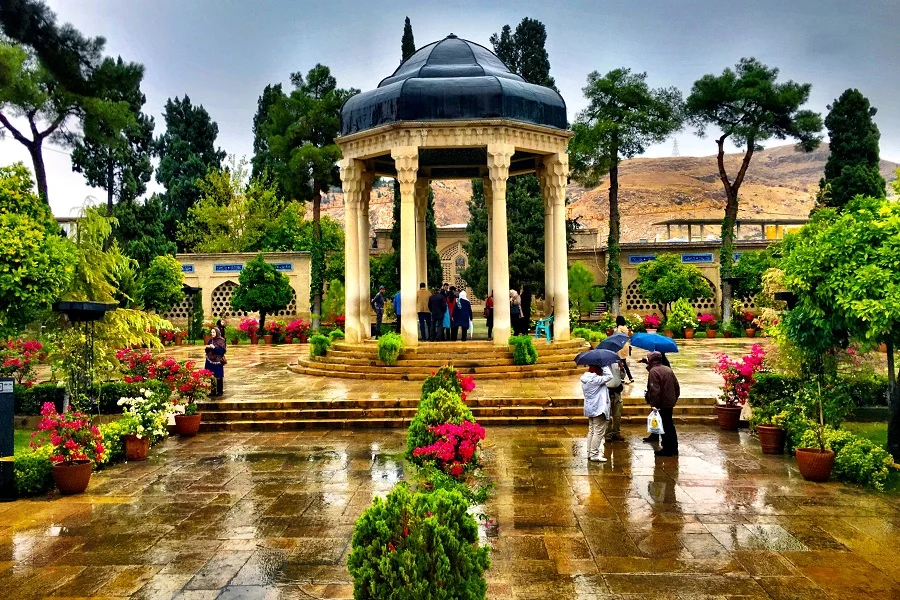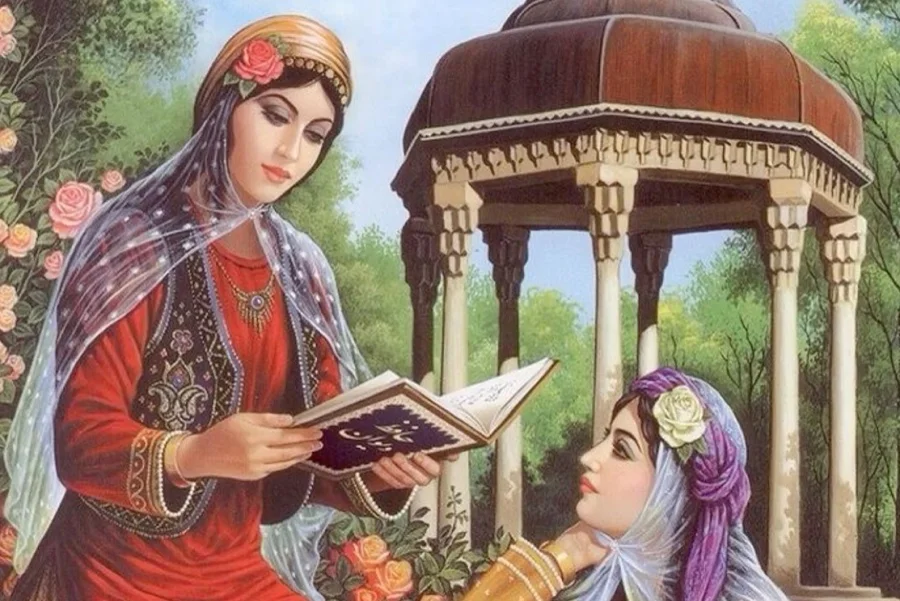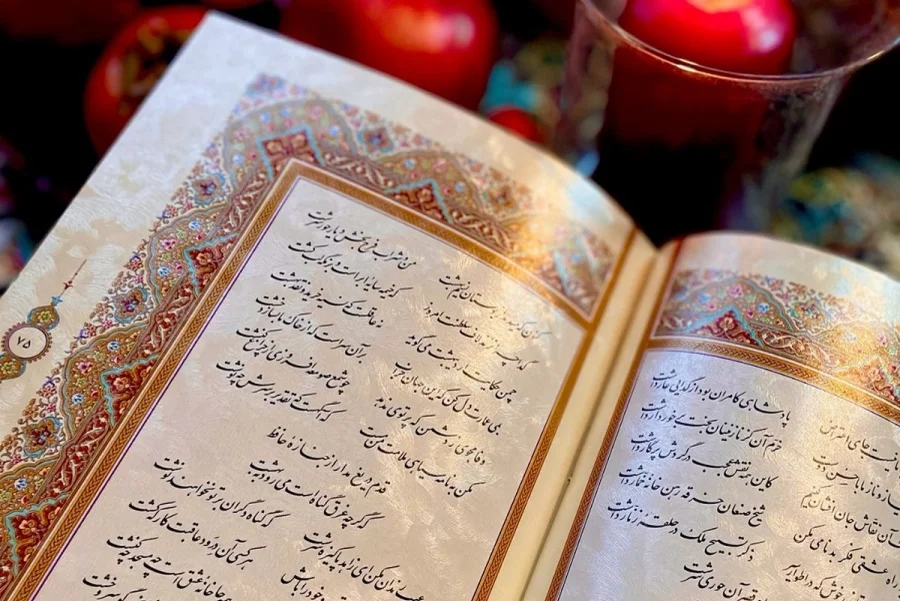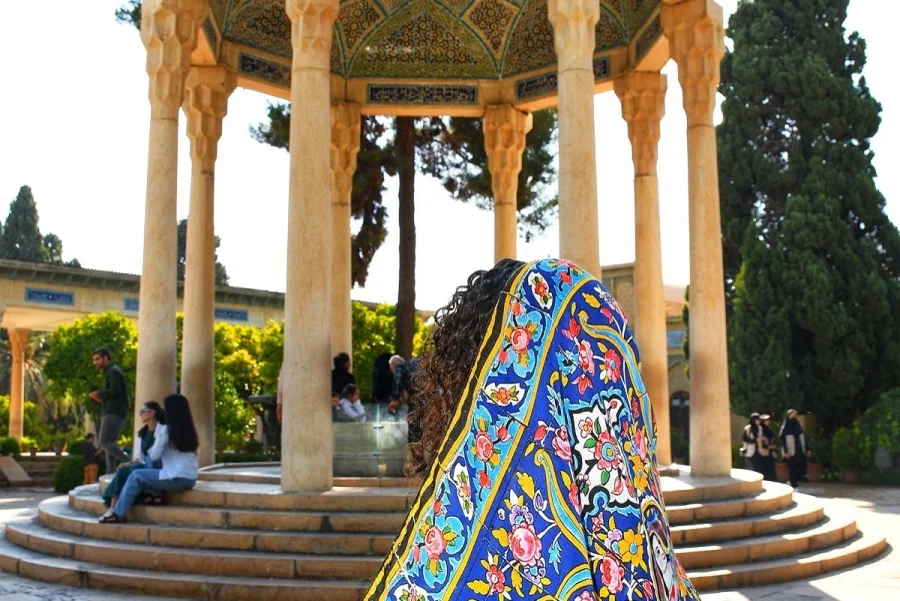
Hafez, the Celebrated Poet from Shiraz
In nearly every Iranian home, you’ll find a copy of Divan-e Hafez, a treasured book of poetry by the renowned Persian poet and mystic, Hafez. His verses have a unique way of touching the soul and stirring the heart with just a few lines. Filled with masterful figures of speech, his poems inspire love, positivity, hope, and resilience, even in life’s most challenging moments. Above all, they encourage living fully in the present. Though he lived centuries ago, Hafez’s words continue to resonate deeply, leaving a timeless impact.
CLICK HERE FOR IRAN TOUR PACKAGES
Hafez’s Life
The life of Hafez, the celebrated poet from Shiraz, remains a mystery despite his lasting impact on Iranian literature and culture. Details about his early years are scarce, with varying accounts and no definitive source to confirm them. Hafez lived during the 8th century, a tumultuous period in history. He was well-versed in the sciences, religion, language, and literature of his time, and he also played a musical instrument. More importantly, Hafez was a keen social observer and critic, often prioritizing societal issues over his poetry, which reflects his deep concern for the world around him.
Hafez’s Titles
In Iranian language and culture, someone who has successfully memorized the Quran is called a “Hafez.” This was not only the title of our beloved poet but also the pen name he chose for himself. Hafez is also known as “Lisan-ul-Qeyb,” meaning “The Tongue of the Unseen,” as many believed his words were inspired by divine connection, carrying messages from the unseen world.
Hafez’s Inspiration
Like many great creators, Hafez was influenced by numerous authors before him. However, what set him apart was his ability to blend these influences in a way that felt completely original. Critics often compare him to a bee, gathering nectar from various flowers to create the sweetest honey. In the same way, Hafez’s work is the essence of Iranian literature. Reading his poetry is like experiencing an entire era of Iran’s literary history.
As mentioned earlier, Hafez was influenced by some of the greatest writers of his time, particularly Omar Khayyam. Khayyam, known for his contributions to mathematics, astronomy, and poetry, is also a major figure in Iranian culture. His verses, which explore themes of love and life, are available in English, allowing readers worldwide to appreciate his timeless wisdom.

Hafez: Biography, Poetry, Ideas, and Beliefs
The Style and Talent of Lisan Ul-Qeyb
Hafez’s poetry is a rich tapestry woven with striking imagery, deep symbolism, and layers of nuanced meaning. He uses these elements to express emotions in a deep and complex way, with layers of meaning that each reader can uncover for themselves.
Hafez’s main style of writing was mystical poetry, known as “Ghazal.” This form of Arabic poetry dates back to the 7th century. Ghazal poetry beautifully expresses the pain of separation and the enduring beauty of love, despite the sorrow and challenges it may bring.
Hafez’s ghazals are deeply emotional, reflecting the poet’s searching soul. What makes his poems unique is that he used the ghazal—a form traditionally associated with love poetry—to express his profound love for God, rather than for a person. He also crafted his poems in a way that encourages the reader to reflect deeply, rather than just reading them passively.
Hafez is a master of using ambiguity in his poetry, where a word or phrase holds multiple meanings. He skillfully weaves this literary technique throughout his work, which is why his poems are not easily understood. To truly appreciate Hafez, one must carefully consider each word and its possible interpretations. Reading Hafez requires more than just reading—it’s about deep reflection. Those who enjoy his poetry need a rich understanding of literature and a strong vocabulary to grasp the full depth of his meaning.
What sets Hafez apart from other poets is that his poems go beyond love. They also touch on historical events, such as the invasion of Timur and the challenges faced by Shiraz at the time. He even names various governors and politicians, sometimes praising their bravery, other times offering criticism. Hafez also criticizes certain Sufis and hermits, believing some used religion and the name of God to deceive others. His poems often highlight the dishonesty and hypocrisy of these figures.
The Ideas of Hafez
Many believe Hafez was a true mystic, but in reality, he wasn’t in the traditional sense. A mystic is someone who undergoes spiritual growth, with a sole focus on God. While Hafez was indeed a mystic, he didn’t follow the same path of spiritual development as figures like Rumi. Instead, Hafez sought the ideal human being and created characters in his poetry to express his views on life.
Hafez refers to this ideal character as the “Rend.” A Rend is a free-spirited person with strong beliefs that go beyond societal norms, yet without any deceit. Hafez himself embodied this ideal, as it was how he aspired to live. As for how Hafez viewed life, he saw it as an ongoing journey of spiritual growth.
Hafez believed that love is the key to reaching God. He saw love as the force that created the world and the answer to all things. In his poetry, love is limitless, eternal, and the ultimate goal for people to strive for throughout their lives, right up to the moment of death. For Hafez, love is the essence that fuels all of existence.
Hafez also teaches us important life lessons, including patience, faith in God, the pursuit of happiness, the value of time, and most importantly, living in the present. Throughout his poems, he often reminds us that life is short and encourages us to make the most of each moment, as tomorrow is never guaranteed. In his own words:
We didn’t come into this beautiful world
to lock ourselves away from love.
We’re not here to capture others,
but to open ourselves more fully to freedom and joy.
The Influence of Hafez on Iranian Life
Hafez’s influence is deeply embedded in Iranian life. His poems are featured in Persian traditional music, visual art, and calligraphy. He shaped Persian literature after the 14th century and remains highly admired by Iranians and literature enthusiasts worldwide. One notable admirer is Johann Wolfgang von Goethe, the renowned German writer, who praised Hafez without borders.
Hafez Day – Honoring the Legacy of the Great Poet
In Iran, October 12th is observed as Hafez Day, a celebration of the poet’s enduring legacy. On this day, scholars, writers, and admirers from around the world travel to Shiraz to honor the great poet at his mausoleum. They come together to read his poems, reflect on his exceptional skill in poetry, and recognize how he captured the essence of the 8th century, influencing generations long after his time.
The Divan-e Hafez
Hafez’s Divan is highly cherished by Iranians. Many use it for fortune-telling, and it can be found in nearly every Iranian home. During occasions like Nowruz or Yalda Night, families gather and open the Divan-e Hafez to a random page, reading the poem as a reflection of what might lie ahead or as a mirror to their current emotions.

Hafezieh – The Mausoleum of Hafez
Our beloved poet Hafez was born in Shiraz in 1315 CE and passed away in the same city in 1390 CE. In 1454 CE, a dome-shaped structure was built over his grave to honor his life and remarkable contributions. The site is surrounded by beautiful rose gardens, water channels, and bitter orange trees. Visitors can view Hafez’s alabaster sarcophagus, which is engraved with his poems.
Hafez’s tomb lies to the south of the Quran Gate, nestled near the Golgast-e Mosalla gardens, a place frequently referenced in his poetry. The original tomb was built by order of Abul-Qasim Babur Mirza, a Timurid governor. However, the story of the dome doesn’t end there.
The History of Hafez’s Mausoleum
The 19,000 square meter gardens not only served as Hafez’s final resting place but also as one of Shiraz’s main cemeteries. Over the next 300 years, notable figures such as Shah Abbas of the Safavid dynasty, Nader Shah, the founder of the Afsharid dynasty, and Karim Khan Zand made significant contributions to the tomb’s construction and enhancement.
When Hafez’s Mausoleum Became a Controversial Topic
After many years, in 1878, a governor of Shiraz built a wooden enclosure around Hafez’s tomb. This led to controversy in 1899 when Ardeshir, a Parsi from India, constructed a shrine around the grave. The Parsis are an ethnoreligious group from the Indian subcontinent who follow the Zoroastrian faith. This action ignited a debate about the site.
Disputes Over Hafez’s Tomb
Ardeshir had received permission to build a shrine using iron and wood. However, a religious scholar, Ali Akbar Fal-Asiri, objected to a Zoroastrian building over the grave of a Muslim. Fal-Asiri and his followers destroyed the structure in protest. The people of Shiraz, who deeply cherished Hafez’s tomb, protested against the destruction. As a result, the government intervened and ordered the reconstruction of Hafezieh.
I wish I could say that everything was resolved with the reconstruction of Hafez’s tomb, but unfortunately, that wasn’t the case. Fal-Asiri refused to accept it and boldly declared that he would dismantle any structure erected there, regardless of whether it had royal approval. As a result, Hafez’s tomb remained in ruins for nearly two years. Finally, in 1901, Prince Malek Mansur installed an iron railing around the tomb, inscribed with Hafez’s verses.
The Design and Architecture of Hafez’s Tomb
The building you see today was completed in 1935, designed by the renowned French architect and archaeologist André Godard. The tomb, its gardens, and the surrounding area are not just a popular tourist spot in Shiraz; they also hold significant cultural, historical, and architectural value, continuing to reflect Iran’s rich heritage.
As mentioned earlier, two memorial structures were built in honor of Hafez. Hafez rests in the open pavilion situated in Musalla Gardens, on the north bank of the Rudkhaneye Khoshk river. Entering the Tomb of Hafez from the north side, you’ll be struck by the grandeur of the space. The four central columns and the two rooms on either side, to the east and west, form a striking and impressive structure.

Various Sections of Hafezieh
The building divides the gardens into two sections: the orange grove in the front and the cemetery in the back. Originally, the tomb was located outside the structure, at the center of the cemetery, with a marble slab marking the grave. The slab was engraved by a calligrapher with excerpts from Hafez’s poetry.
The interior of the new tomb is supported by eight pillars and adorned with vibrant, colorful tiles. It features four central pillars with open sides, extending to both the east and west. Additionally, several facades and columns are engraved with ghazals and other excerpts from Hafez’s poetry.
His tomb is a popular destination, often filled with visitors paying their respects. The atmosphere is lively, with people singing and reciting their favorite Hafez poems. Tourists who come to Shiraz and visit the tomb can also enjoy the beauty of the Persian garden, the nearby river, and the peaceful, serene ambiance of the place.
Exploring the Poetry of Hafez
Some words and emotions in his poetry are so deeply rooted in Farsi that they cannot be fully translated into any other language. The figures of speech in his work are equally unique, adding to the brilliance of his writing. As one scholar puts it, “Hafez celebrated the joys of love and wine while also challenging religious hypocrisy.” His poems captivate both the heart and the mind, offering beauty and meaning that transcend the ordinary. Read his verses to your loved one, read them to yourself, and immerse yourself in a world of profound beauty and wisdom beyond this earthly realm.
His presence continues to inspire people, as they understand the deep emotional and aesthetic significance of this place. It is believed that more than 500 poems are attributed to Hafez, either entirely or primarily written by him. We hope you can discover some of his finest works, connect with his spirit, and enjoy the beauty of each word.

